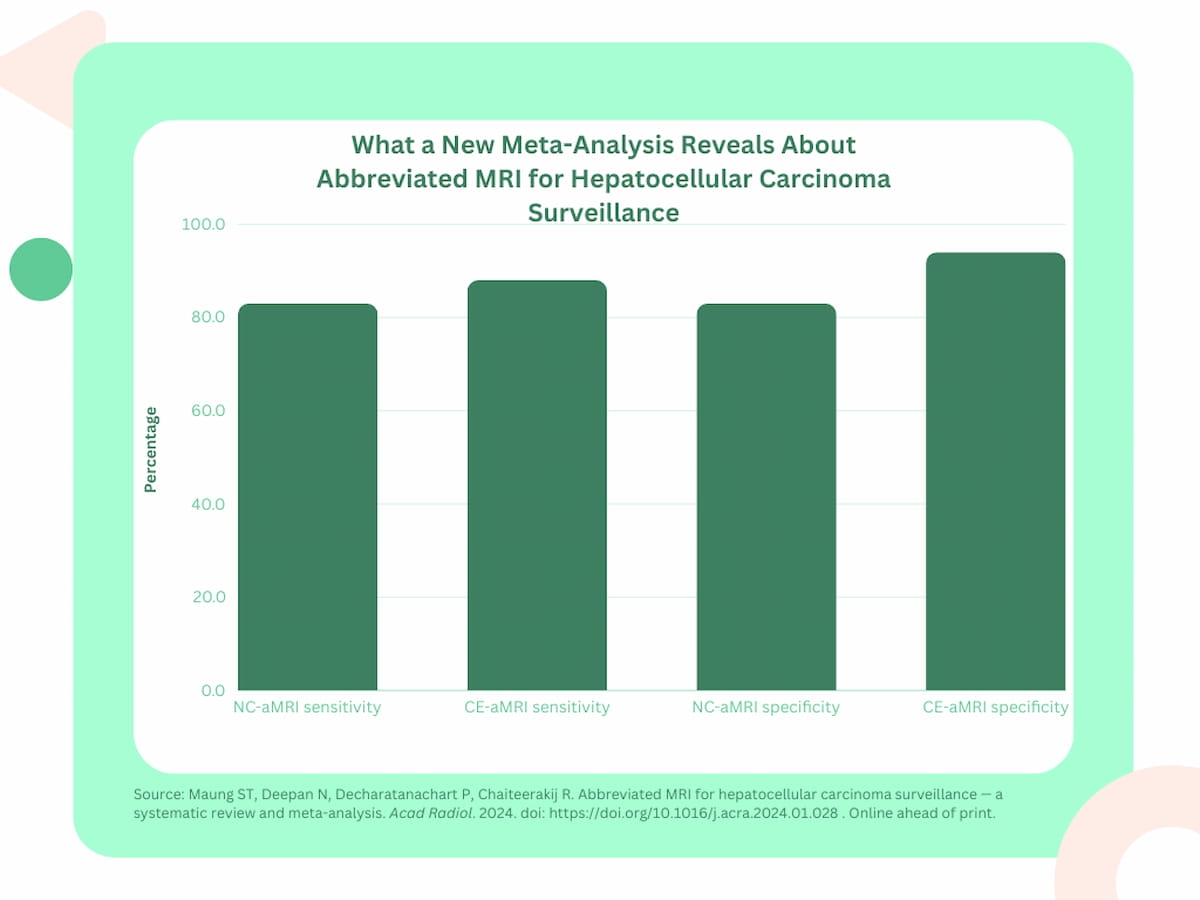While magnetic resonance imaging (MRI) has not been a traditionally recommended first-line modality for hepatocellular carcinoma (HCC) surveillance, a new meta-analysis suggests that non-contrast abbreviated MRI (NC-aMRI) has potential promise in this patient population.
For the meta-analysis, recently published in Academic Radiology, researchers reviewed 27 studies in their comparison of NC-aMRI and contrast-enhanced abbreviated MRI (CE-aMRI) for the surveillance of patients with HCC.
The researchers found no significant differences in sensitivity or specificity rates between NC-aMRI and CE-aMRI. Specifically, the study authors noted that NC-aMRI had a pooled sensitivity rate of 83 percent and a pooled specificity rate of 91 percent in comparison to 88 percent sensitivity and 94 percent specificity for CE-aMRI.
“The present meta-analysis found that aMRI (abbreviated MRI) protocol, both NC-aMRI and CE-aMRI, exhibit good overall performance for detecting HCC and can be considered clinically useful for HCC surveillance. … The advantages of aMRI over full MRI, such as reduced scanner time, cost, and complexity, make it a cost-effective strategy for HCC surveillance,” wrote lead meta-analysis author Soe Thiha Maung, M.D., who is affiliated with the Division of Gastroenterology within the Department of Medicine at Chulalongkorn University and King Chulalongkorn Memorial Hospital in Bangkok, Thailand, and colleagues.
The study authors also compared different NC-aMRI protocols including diffusion-weighted imaging (DWI) alone, a combination of DWI with T2-weighted imaging (T2WI), and a combination of DWI, T2WI and T1 weighted imaging (T1WI). While the researchers found no significant differences in sensitivity or specificity with the different NC-aMRI protocols, they pointed out certain limitations that may affect the detection of HCC.
“HCC often manifests as iso- to hypo-intense on T1-weighted images, complicating differentiation. Similarly, on T2-weighted images, some HCCs may mimic liver signal intensity or blend into heterogeneous cirrhosis-induced parenchymal signals,” noted Maung and colleagues. “ … DWI, a pivotal element in NC-aMRI, is vulnerable to artifacts and blind spots, particularly in regions like the liver dome, compromising its reliability.”
Three Key Takeaways
- Non-contrast abbreviated MRI (NC-aMRI) shows potential promise for hepatocellular carcinoma (HCC) surveillance. Despite not being traditionally recommended as a first-line modality, a new meta-analysis suggests that NC-aMRI, with its advantages of reduced scanner time, cost, and complexity, exhibits good overall performance for detecting HCC and can be considered clinically useful for surveillance.
- Comparable sensitivity and specificity with contrast-enhanced abbreviated MRI (CE-aMRI). The meta-analysis found no significant differences in sensitivity or specificity rates between NC-aMRI and CE-aMRI. NC-aMRI had a pooled sensitivity rate of 83 percent and a pooled specificity rate of 91 percent, comparable to CE-aMRI with 88 percent sensitivity and 94 percent specificity.
- Optimal protocol for NC-aMRI. While different NC-aMRI protocols, including diffusion-weighted imaging (DWI) alone, a combination of DWI with T2-weighted imaging (T2WI), and a combination of DWI, T2WI, and T1-weighted imaging (T1WI), showed no significant differences in sensitivity or specificity, the combined protocol with DWI, T2WI, and T1WI demonstrated sensitivity and specificity rates of 87 percent. T2-weighted imaging was highlighted for its role in differentiating between malignant and benign lesions, aiding in the surveillance of HCC.
However, they did note that the combined NC-aMRI protocol with DWI, T2WI and T1WI had sensitivity and specificity rates of 87 percent. The researchers also pointed out that T2-weighted imaging can play a significant role in differentiating between malignant and benign lesions.
“Mild to moderate hyperintensity of HCC on T2-weighted images contrasts starkly with marked hypointensity or hyperintensity typically found in non-malignant lesions like cysts, hemangiomas, or fibrosis,” added Maung and colleagues.
(Editor’s note: For related content, see “Emerging Model with Key MRI Feature Improves Prediction for Advanced Recurrence of Hepatocellular Carcinoma,” “Large MRI Study Links High Proton Density Fat Fraction to Elevated Liver Disease Risks” and “Meta-Analysis Assesses Impact of Radiomics for Predicting Hepatocellular Carcinoma Recurrence.”)
In regard to study limitations, the authors conceded that some of the reviewed studies utilized contrast-enhanced MRI as a diagnostic reference standard and acknowledged a lack of sensitivity and specificity assessment at the per-lesion level. The researchers also noted the majority of the cohorts in the reviewed studies were comprised of patients with indeterminate liver lesions as opposed to true surveillance populations.
